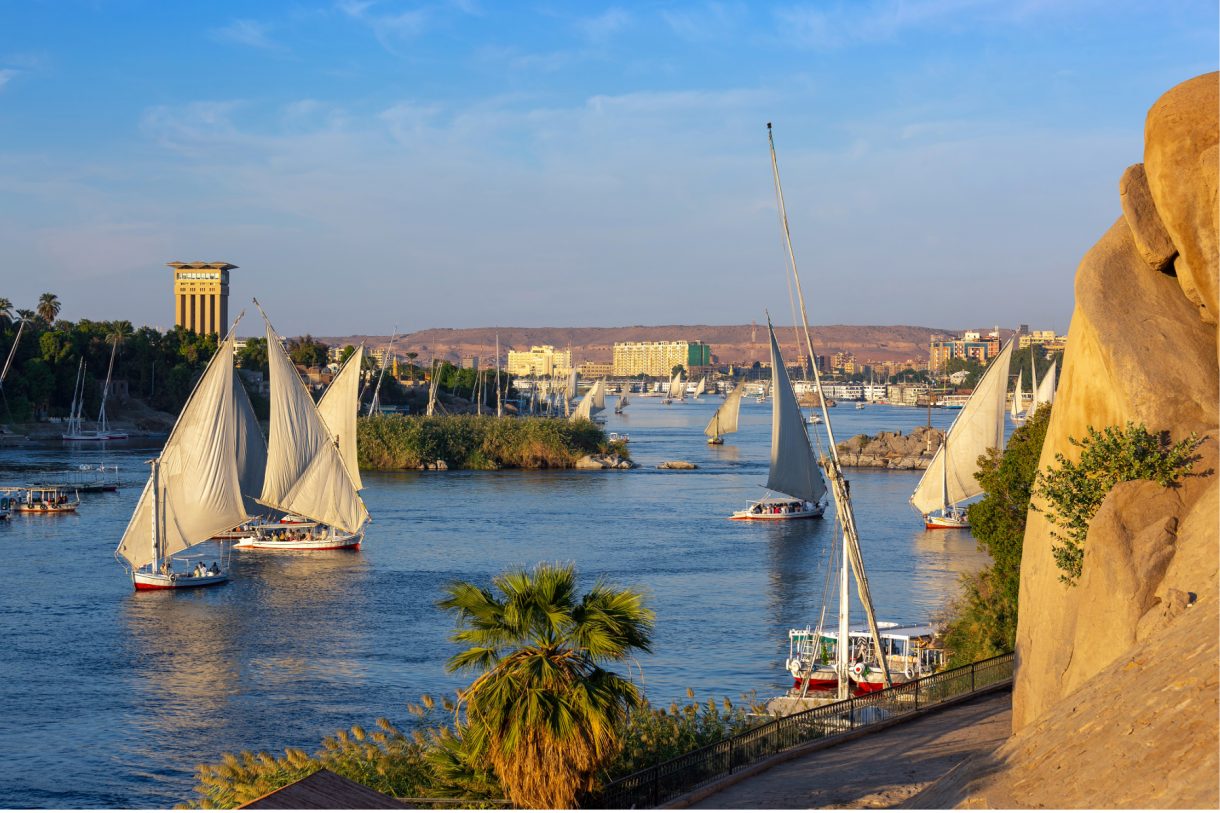
Plan Your Visit to Elephantine Island, Aswan: Museum, Ruins, and Nearby Highlights
In a country of dirty, busy and chaotic cities, Aswan’s Elephantine Island is a peaceful escape. There are no cars. You can wake up and enjoy a coffee over the beautiful Nile. And the residents are just the nicest people! There’s also tons to do, making Elephantine Island is the perfect place to base yourself when visiting Aswan. Read more about the things to do at Elephantine Island, including our guide to Elephantine Island’s Museum and ruins, how to get there, and things in the area you absolutely shouldn’t miss!
Zoom in for things in Aswan you shouldn’t miss, plus restaurant recommendations, public transport terminals, and more!
WHY VISIT ELEPHANTINE ISLAND?
Elephantine Island is a small island nestled in the heart of the Nile. It’s a short boat ride from Aswan, in south Egypt. The Nubian people call this island home. And the unique culture in the Nubian villages of Siou and Koti make a surprising counterpoint to the bustle of the rest of Egypt’s cities.
Often overlooked in favour of Aswan’s major attractions, Elephantine Island has a lot to offer. But when we tried to plan a day exploring the ruins and museums of Elephantine Island, all we found online were people selling tours, and inaccurate AI-generated blog posts (sadly seeing more and more of these recently).
That’s why we’re writing this guide! We didn’t know what to expect, but now we have tons of first-hand knowledge to share with you. So get comfortable as we take you through everything you need to know about Elephantine Island, including the Aswan Museum, the Elephantine Island ruins and the ancient Nilometer.
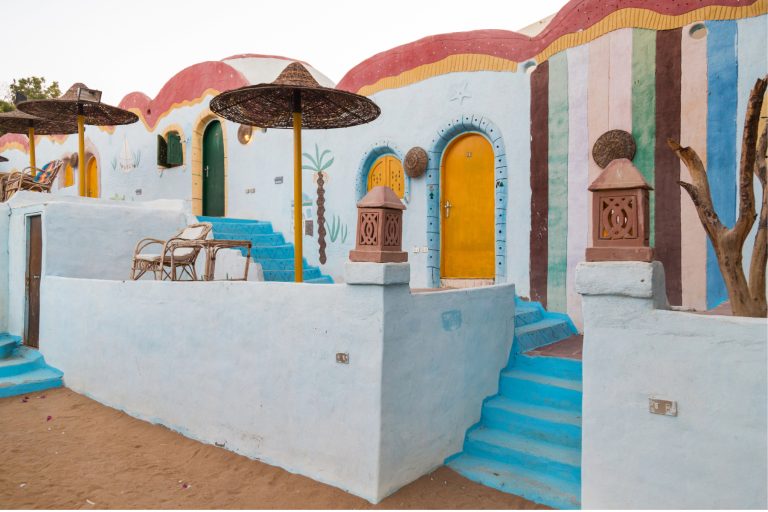
A (VERY) BRIEF HISTORY OF ELEPHANTINE ISLAND
Elephantine Island has been inhabited for over 5000 years, with archaeological findings dating back to 3100 BCE. The island’s strategic location made it an important spot for trade between Nubia and Egypt, allowing goods from both regions to be exchanged without having to cross oceans or deserts. The people controlling the island also had control over water-based trade routes and access to southern Egypt.
Proximity to major cities, such as Aswan, also made the island an important area for religion. The Temples of Satet and Khnum, dedicated to the Nile gods responsible for the annual floods, were important pilgrimage sites during Pharaonic times.
Over the centuries, Elephantine Island has been subject to Nubian, Persian, Greek, and Roman control. Each of these civilisations left their own architectural mark on the island and a treasure trove of archaeological wonders have since been discovered. Although the island may be small, there’s tons here to explore.
Nowadays, Elephantine island is inhabited, once again, by the Nubian people. The Nubian people are an ethnic group indigenous to the region of southern Egypt and northern Sudan. Nubians are known for their colourful traditions, music, and dance. Their culture is characterised by gorgeous, bright clothing, intricate jewellery, and a strong sense of community. Their influence can be seen in the island’s art and architecture of Elephantine Island, and the Nubian Annex of the Aswan Museum is dedicated to showcasing this heritage.
So what is there to see? Let’s dive in!

THE ASWAN MUSEUM
The Aswan Museum is a small museum located on the southern tip of Elephantine Island. Despite its size, the museum contains thousands of year’s worth of artefacts and relics found right there, on Elephantine Island.
Although small, the museum showcases a remarkable collection of items from various periods of Egyptian history, from prehistoric times to the Islamic era. There are coins, jewellery, pottery shards, and even ancient marriage contracts. These provide a valuable insight into how people lived in this area. With so many artefacts in such a small place, the Aswan Museum is a whistlestop tour of 5000 years of Egyptian history.
YOUR GUIDE TO THE ASWAN MUSEUM:
I really liked the Aswan Museum, as unlike Egypt’s larger museums, it wasn’t too overwhelming!
It’s not just relics from the time of the Pharaohs either. If you’re anything like me, you’ll get a bit ‘Pharaohed-out’ after hitting all of Egypt’s must-see sites. So having some other parts of history to explore was a welcome relief.
Keep a look out for:
- Early tools and pottery:The museum contains collections of the earliest tools and pottery used by the island’s inhabitants. These date back to 3100 BCE, and are an important insight into the daily lives of the original inhabitants of Elephantine Island
- Ancient Egyptian Pharaonic Relics: As with most Egyptian museums, the Aswan Museum has an impressive collection of statues, stelae, and inscriptions from the Pharaonic period. Particularly interesting are the statues of the gods Khnum and Satet, who were worshipped on the island.
- Roman and Byzantine Artefacts: It’s not all Ancient Egypt! Aswan Museum is a great place to explore the influence of the Roman and Byzantine periods on Egypt, with a good collection of intricate mosaics, coins, and ceramics.
- Islamic Treasures: The museum also houses artefacts from the Islamic period, including beautifully crafted pottery and textiles. The most interesting of these are a set of Islamic marriage contracts.
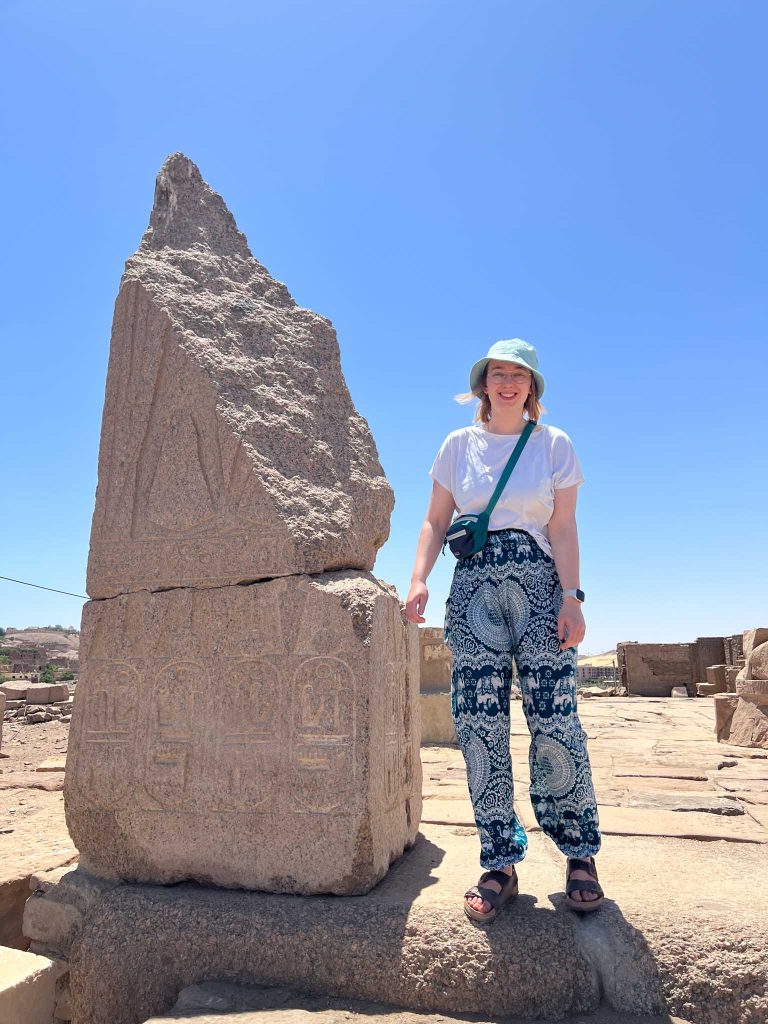
THE ASWAN RUINS
The island is most famous for its ancient temples, which date back to the Old Kingdom period (2686 – 2181 BC). Some of the best ones include:
#1 THE TEMPLE OF KHNUM
The temple was dedicated to Khnum, the god responsible for controlling the annual flooding of the Nile river. This was super important, as annual floods were key for fertilising the fields along the Nile. Inside this temple are statues of Khnum, along with other gods, such as Anuket and Satis.
#2 TEMPLE OF SATET
A sanctuary to the Nile Goddess, the Temple of Satet is one of the most significant religious sites on Elephantine Island. Satet was believed to be the goddess who controlled the flooding of the Nile. The annual flooding was a crucial event: more floods meant more food, and less floods meant possible starvation across the country. So, appeasing Satet was important to ensure a bountiful harvest.
The temple dates back to the Early Dynastic Period, when it was an important pilgrimage site for pharaohs and common people alike. The temple also likely had a central role in coordinating water management during the flood season. Here are the things to look out for:
- The Main Sanctuary: The heart of the temple where the statue of Satet resided. The sanctuary is adorned with intricate carvings depicting the goddess and various rituals performed in her honour.
- The Processional Way: A ceremonial pathway leading to the temple, flanked by statues and stelae.
- The Sacred Lake: Used for purification rituals, this lake symbolizes the connection between Satet and the Nile.
#3 THE NILOMETER
The Nilometer is one of the most historically significant structures on Elephantine island. Carved into the rock, the nilometer is a series of stone steps leading down to the river, with markings to indicate the water level.
By measuring the river’s water level, the Nilometer helped predict the intensity of the annual flood. This information allowed for proper allocation of water resources and helped farmers prepare for the upcoming growing season. The authorities could forecast crop yields and potential shortages and plan accordingly.
Today, you can walk down the steps of the Nilometer and imagine the ancient rituals and ceremonies that once took place here. Flooding along the Nile is no longer an issue. The annual flood is controlled downstream at the artificially created Lake Nasser, and modern agriculture ensures the people of Egypt can continue their farming along the banks of the Nile
#4 THE ROMAN FORT
The Romans built on top of the existing Pharaonic buildings on Elephantine Island. Still being unearthed, the Roman ruins showcase the interesting history of Romans in Egypt.
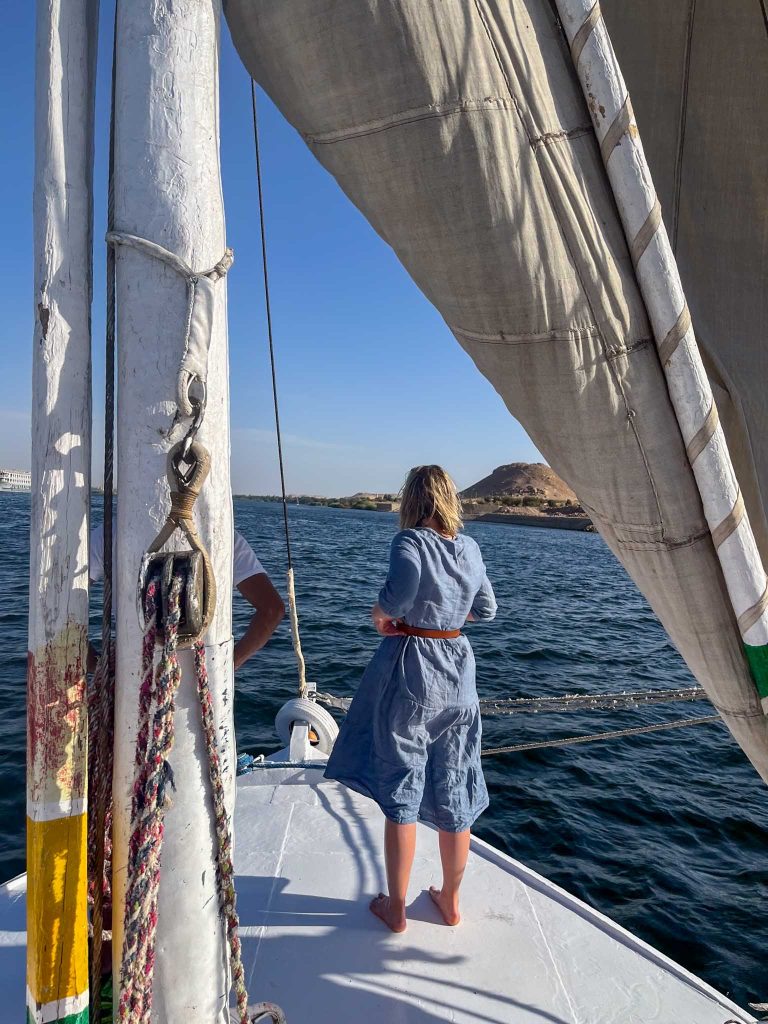
THE ELEPHANTINE ISLAND RUINS & MUSEUM: HOW MUCH DOES IT COST?
Visiting the island itself is free. But entrance to the Aswan museum AND the ruins costs 200 EGP (or 100 EGP for students/children). This is a bargain compared to other museums in Egypt!
THE ELEPHANTINE ISLAND RUINS & MUSEUM: WHAT TO EXPECT
I really enjoyed the museum and the ruins. Both sites have very minimal harassment, which gives you the time and space to enjoy exploring the museum.
So, what should you expect? After you buy your ticket, one of the guards will accompany you to the museum, unlock it, and switch the lights on (yep, that’s how quiet it is compared to other sites!). Sometimes the guard may explain the history a little, but this depends on their English proficiency. All signs are bilingual, in English and Arabic, and are very descriptive, so you don’t need to worry.
Once you finish up in the museum, you can head up to the ruins. Another guard will accompany you, which is non-optional as this is an active archaeological dig site. We rolled our eyes a little at this. We were sick of being hounded by ‘guides’ and really don’t enjoy being followed and told things we already know, and then harassed for money at the end.
However, the guards seemed genuinely helpful, and unlike most archaeological sites across Egypt, they didn’t seem to be hustling for a tip. In fact, the guard taking us around seemed pleasantly surprised when we offered a small tip at the end, initially declining it. It was a really genuine experience of Egyptian hospitality.
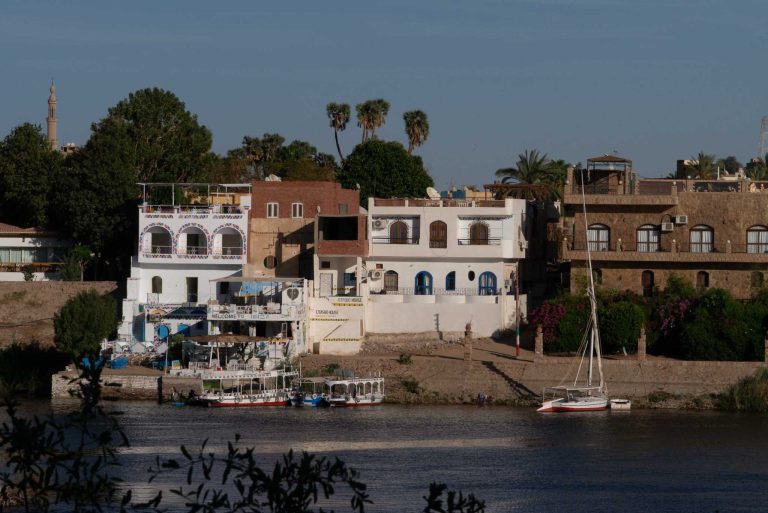
PRACTICAL INFORMATION FOR VISITORS:
HOW TO GET TO ASWAN
Train: This is the route we took! Aswan is well-connected by train to other major cities in Egypt. Trains offer a scenic journey along the Nile, and Aswan’s train station is pretty centrally located. We took the night train, which left the bustling centre of Cairo in the evening. We woke up to beautiful views of the Nile, and a welcome pot of steaming coffee from the train conductor.
Bus: Although less comfortable, Egypt’s GoBus and GoMini are cheap options to travel around the country, even if they do compromise on efficiency.
Nile Cruise: Many tourists arrive in Aswan as part of Nile River cruise packages. These cruises often start in Luxor and journey south along the Nile, stopping at various historical sites along the way, including Aswan and Elephantine Island.
Flight: If you’re arriving directly from your home country, you might want to consider starting your trip from Aswan International Airport (ASW), and working your way north overland to explore the rest of Egypt. Otherwise, we don’t recommend flying within Egypt. There are better, more sustainable ways to travel!
HOW TO GET TO ELEPHANTINE ISLAND
Elephantine Island is accessible by boat from Aswan. Ferries operate regularly. The public ferry leaves from the ferry dock, across from the KFC. It should cost 10 EGP per person, and the ride only takes a few minutes. It’s important to note that men and women sit separately on the ferry. Do respect this.
The cost is written on a sign at the docks, and you pay before heading into the waiting area (or straight to the boat). If it costs more than 10 EGP, you’re being scammed my friend!
You can also take a felucca, a private sailboat, across to the island. This is more expensive, but the journey offers stunning views of the Nile and the surrounding landscape.
BEST TIME TO VISIT ELEPHANTINE ISLAND
The best time to visit Egypt, and Elephantine Island, is during the cooler months, from October to April. The weather is warm, but not uncomfortably so, making it ideal for exploring. Avoid visiting during the peak summer months, as temperatures can be extremely high.
Winter (November to February) is peak tourist season in Egypt, with mild weather and cool evenings. Daytime temperatures typically range from around 18°C to 25°C (64°F to 77°F). Early Spring (March to April) is another popular time to visit Egypt as the weather is slightly warmer, usually between 20°C to 28°C (68°F to 82°F). Shoulder season, the months of October and late April/May, will still have nice temperatures, but fewer tourists.
PLACES TO STAY NEAR ELEPHANTINE ISLAND:
Aswan also offers a range of options to suit all budgets. From luxury hotels to budget-friendly hostels, you’ll find a variety of places to stay. Many hotels also run their own boat taxi or offer boat trips to the island.
Elephantine Island itself is also a wonderful place to base yourself. We stayed in the Nubian Village on Elephantine Island during our time in Aswan. There are dozens of locally run Nubian guesthouses, and you bring income to an area that may receive less than the main city. It’s a lot quieter than the main city too. Imagine sipping your morning coffee on the banks of the Nile, watching the felucca boats sail up and down. That’s the vibe!
TOP TIPS FOR VISITING ELEPHANTINE ISLAND:
- Wear comfortable shoes: The island’s terrain can be uneven, so sturdy footwear is essential. The island is also very dusty, so wear closed shoes if you want to avoid getting your feet dirty.
- Stay hydrated: Bring plenty of water, especially if you’re visiting during the warmer months.
- Respect local customs: Dress modestly and be mindful of local traditions and customs.
- Take your time: There’s a lot to see and explore, so don’t rush your visit. Allow yourself ample time to fully appreciate the island’s wonders.

OTHER THINGS TO DO NEAR ELEPHANTINE ISLAND
#1 TEMPLE OF ABU SIMBEL
The Temple of Abu Simbel is still a day trip away from Aswan, but it’s easily one of the most iconic and memorable historic sites that we visited.
The Temple of Abu Simbel is a few hour’s drive south of Aswan, near the border with Sudan. This area, known as Nubia, was rich in gold and other precious trade goods. Pharaoh Ramesses II ordered the twin temples to be carved out of the mountainside (~1264 BC), as he tried to impress the Nubian people.
The 20-metre (60 ft) tall figures of Ramesses II are some of the most impressive we saw in Egypt, and the artwork inside is well preserved. The temples are pretty far south, so only a few hundred tourists visit each day, giving you a more relaxed and intimate experience than other popular temples in Egypt (looking at you, Karnak)
#2 ASWAN BOTANIC GARDEN
This may sound incredibly nerdy, but I did my degree in Botany (Plant Science). I love to visit any botanic garden, no matter where I am in the world, and Aswan Botanic Garden was no exception.
Aswan Botanic Garden is on El Nabatat Island (next to Elephantine island). The island which used to be owned by British Lord Kitchener in 1911, who transformed it into a garden full of exotic, imported plants. Now, the island is owned by the Egyptian government, but it is still home to hundreds of species of flora and filled with birds, lizards, and butterflies. It’s a beautiful place to visit, particularly just before sunset when the light is soft and the temperature cooling.
You can supposedly take a ferry over, but we couldn’t find it. We ended up following some local kids, who told us they were taking us to the ferry, and the ‘ferry’ ended up being their private rowboat! We got to the garden, they pocketed the cash and rowed us over, and we were all happy with the outcome!
#3 PHILAE TEMPLE
The Philae Temple is one of the most enchanting spots in Aswan. Located on nearby Agilkia Island, it’s only accessible by boat, which makes the journey there feel like an adventure in itself. The temple is dedicated to the goddess Isis and has a fascinating history, including being relocated to save it from flooding after the construction of the Aswan High Dam.
The Philae Temple is one of the most enchanting spots in Aswan. Located on nearby Agilkia Island, it’s only accessible by boat, which makes the journey there feel like an adventure in itself. The temple is dedicated to the goddess Isis and has a fascinating history, including being relocated to save it from flooding after the construction of the Aswan High Dam.
#4 VISIT A NUBIAN VILLAGE
Visiting a Nubian village is a great way to experience the rich culture and vibrant history of the Nubian people, who have inhabited this region for millennia. The colourful houses, friendly locals, and unique traditions make for an unforgettable experience. We stayed in the Nubian villages on Elephantine Island, where we got to explore the village’s bustling markets and enjoyed a traditional Nubian meal.
#5 UNFINISHED OBELISK
The Unfinished Obelisk is one of Aswan’s most intriguing sights, offering a rare glimpse into ancient Egyptian stone-working techniques. This massive obelisk, which would have been the largest ever erected had it been completed, remains partially carved out of the bedrock. Unfortunately, a crack in the stone led to the project being abandoned, but the site is still fascinating.
Walking around the obelisk, you can see the tool marks and learn about how the ancient Egyptians managed to carve and transport such colossal structures. It’s a quick visit, but definitely worth it if you’re interested in Egyptology or ancient engineering.
#6 FELUCCA RIDE ON THE NILE
A trip to Aswan wouldn’t be complete without a felucca ride on the Nile. These traditional wooden sailing boats offer a peaceful way to explore the river and take in the stunning landscapes surrounding Aswan.
We hired a felucca for an entire afternoon with two brothers. We sailed up and down the Nile until sunset, stopping to make traditional coffee, or jump in for a swim. It was one of the most relaxing experiences of our trip.
Gliding along the water with the warm breeze in your hair, watching the sun dip below the horizon, and seeing the riverbanks come alive with birds and fishermen—it’s pure bliss. The felucca owners are usually very friendly and love to share stories about life on the Nile, making the experience even more memorable.

We hope that this guide to Elephantine Island, the Aswan Museum and Ruins has been useful! If you liked it, or if you find anything has changed since our visit, please drop us a message! It’s really important to us that we keep this blog up to date and accurate. Enjoy your visit to Elephantine Island!
LIKE IT? PIN IT!
SAVE THIS POST TO YOUR PINTEREST BOARD TO COME BACK LATER
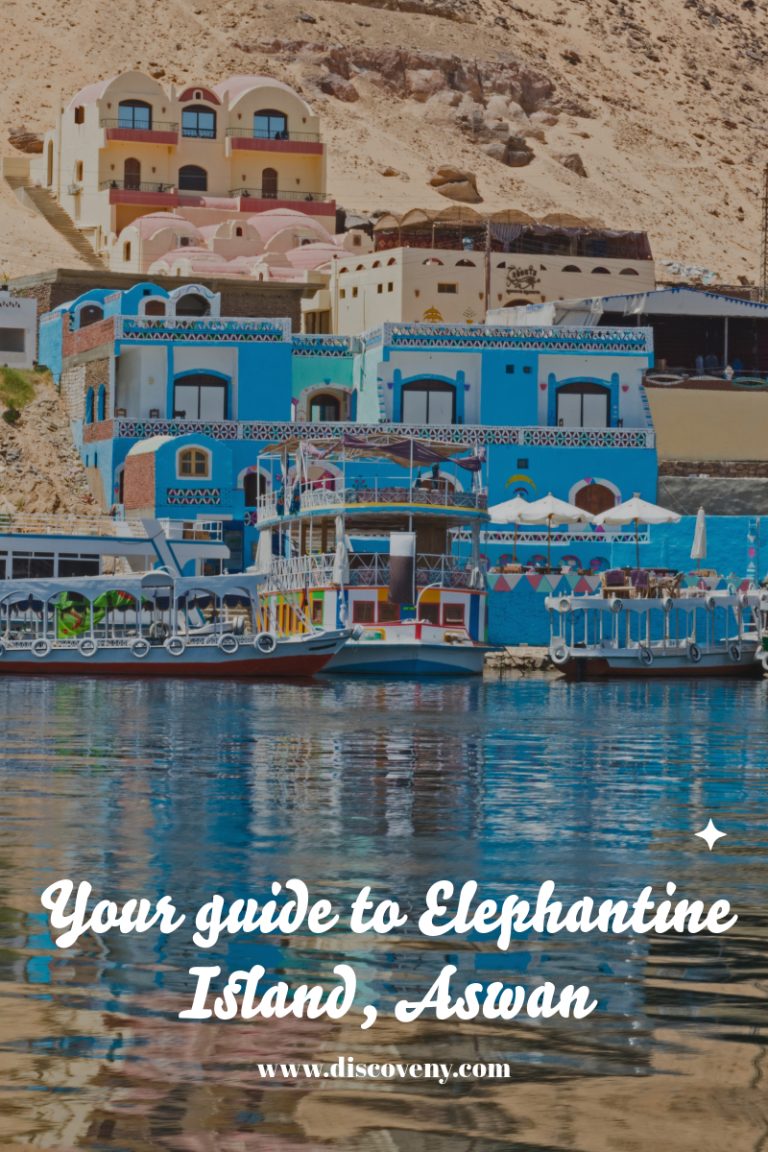

Follow our daily adventures on Facebook and Instagram
Disclaimer: The information and advice provided in this blog are the author’s opinions and based on their personal experiences. All information was accurate at the time of writing. However, things can change quickly, so always double-check current conditions and guidelines before setting out. Remember, your travels and safety are your own responsibility, and this blog can not be held responsible for anything that might happen on your adventures! Always exercise caution and good judgment. Oh, and don’t forget to get travel insurance! Happy travels!
This post may contain affiliate links (yay for transparency!) This means that I will earn a small commission, at no additional cost to you, if you click the link and choose to buy the product. I only link to stuff I have personally bought and found useful and never endorse crap. Your support helps keep the site going, thank you!
Alice
Alice is a UK travel blogger who advocates sustainable travel and being more eco-conscious on a budget. She loves coffee, her houseplants and summiting mountains.
You May Also Like
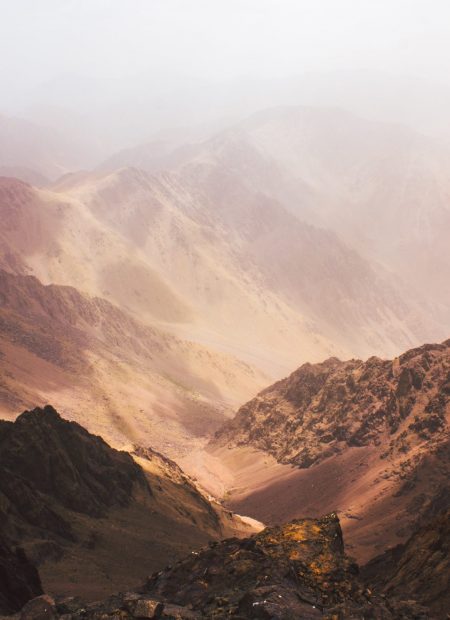
Everything you need to know before hiking Mount Toubkal
June 17, 2020
What do things cost in Morocco?
January 21, 2025